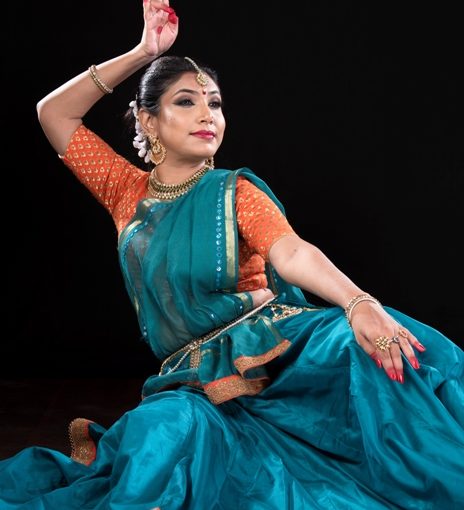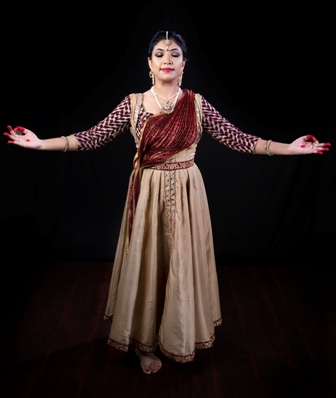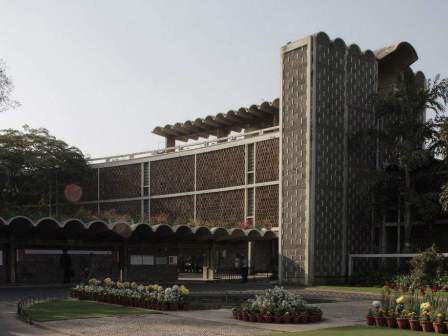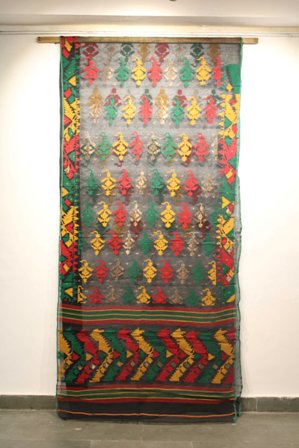

Cultural Correspondent
The India International Centre in New Delhi resumed its cultural programmes after the long spell of pandemic-induced curbs. On September 29 evening, IIIC unveiled its Double Bill music and dance recitals at the CD Deshmukh Auditorium.
An exciting exhibition of world-famous classic Jamdani sarees was also on at the nearby IIC art gallery, attracting hordes of visitors.
Hindustani recital by Dr. Rita Dev
The artistic evening started off with the Hindustani recital by Dr Rita Dev, the famed disciple of legendary vocalist Padma Vibhushan Dr Girija Devi. Rita Dev is a distinguished vocalist from the Banaras Gharana and also a professor of music at Agra University.
In her recital, Dr. Rita Dev was accompanied by Durjoy Bhowmik on the tabla, Aanchal Singh and Harvinder Singh on Tanpura with Zakir Dholpuri playing the harmonium.
Rita Dev is known for an extensive repertoire covering many genres in classical and semi-classical including Khyal, Thumri, Dadra, Kajri, Holi, Jhoola, Chaiti, Tappa and Bhajan.
Rita Dev kept the audience spellbound with her renderings. They included a khyal in Rag Puria. “Kijey Kripa apno jaan, jag janani bhavani.... followed by “Milan Morey Shyam” in druth thaal.

When Rita Dev moved to crescendo during the rendition with a line “Kaisey likhum pathiya piya ka avan ki” the audience looked breathless in awe of the musical magic.
The recital was an affirmation of her credentials as an approved ICCR artist; Grade A artist of the All India Radio and a prominent figure in many musical TV presentations such as MausiqiEkKhoj, Aradhana, Swaaranjali and many more.
The recital reiterated Dr Rita Dev’s brilliance in terms of imaginative presentation, mastery over the melody, and the rare skill of renditions in aalap, sargam in delivering a classy, and divine experience.
Kathak by Sangita Chatterjee
The recital was followed by Kathak dance by renowned Kathak artiste Sangita Chatterjee from Delhi, the disciple of Smt Vaswati Misra.
Sangita is quite famous in India and abroad as a young, dynamic and eminent Kathak exponent from Lukhnow Gharana.

At IIC, Sangita presented Durga sthuthi (invocation) and enthralled the audience with the subtle abhinaya conjoining a melange of lyrical and sensuous movements in scintillating rhythmic patterns fitting the essence of the myth into the Kathak rubric.
Sangita Chatterjee’s fabulous performance expressed Devi Durga in many powerful manifestations of “aadi parashakti.” The stellar performance exemplified the concept of Durga as the primordial cosmic energy that moves the universe.
Brilliant lighting captured the masterly expressions and brought home Durga’s myriad facets with all clarity as Durga’s cosmic energy dazzled and powered the rhythmic steps.
Durga is deemed formless yet she takes many forms. Durga is the divine creative force that sustains life and destroys evil. Devi Durga, as a divine mother of all, rides a tiger and has annihilated many demons including Shumbha and Nishumbha. The Goddess readily answers the prayers of salvation by the faithful.
Sangita has given graceful solo performances all over India and in many parts of the world. She is a panelled artist of ICCR, SPIC MACAY and the Ministry of Culture. She has given countless solo performances in India, Europe, Asia, America, Africa, besides workshops and lecture demonstrations.
Sangita has won many awards including Sringar Mani, Jayadev Samman, and women achievers awards by many prestigious organizations.
Sangita Chatterjee is also the artistic director of the cultural organization Kalpataru Arts. Sangita also curates festivals of dance, music, and also produces dance films under her organization.
DHAKAI JAMDANI SAREES EXPO
The India International Centre also hosted an exhibition of museum quality DhakaiJamdani sarees from the collection of Siddhartha Tagore.
The exhibition at the Art Gallery, in Kamaladevi Complex of IIC, started on Sept 21 and was a proclamation of Jamdani’s importance as an integral part of India’s ancient textile legacy.

The expo has an apt title ‘A Glorious Past and a Shining Future for Dhakai Jamdani’ and is curated by Puneet Kaushik and Rema Kumar. It will conclude on Oct 4.
The Dhakai jamdani transports the viewers to a bygone nostalgic old world where weaving was revered for its artistry and glory. The brisk sale of pieces of Jamdani expressed that sentiment.
This exhibition was a reaffirmation of the aesthetic value and great artisanship that produced the intricate Jamdani saris that draped royalty and aristocrats as a perennial source of excitement to discerning textile lovers.
Jamdani was originally called Dhakai, after the city of Dhaka from East Bengal, now Bangladesh, where it was exclusively hand-woven for many centuries. In its purest form, Jamdani denotes muslin, the fine cotton fabric with geometric or floral motifs woven on handlooms by amazing weavers of Rupganj, Narayanganj, and Sonargaon around capital Dhaka.

Muslin was also the chosen clothing for statues of goddesses in ancient Greece and countless emperors from distant lands.
Undivided India’s textile legacy
The exhibition’s jamdani sarees manifested the superb quality and the skill of artisanship in the pre-British Raj era evident in nicely displayed sarees woven in Dhaka in the late 19th century along with a few pieces produced under the East India Company.
Dhakai saris reached the pinnacle of fame during the Mughal empire and elevated the flourishing trade into an art exchange. Enamoured by the masterly finishing Mughals gave a Persian name as a tribute to the floral patterns with ‘Jam’ meaning flower and ‘Dani’ meaning vase.

The decline of the Bengali jamdani and muslin started under the British Raj who promoted mill-produced European textiles such as Manchester cotton. By the early 20th century, Dhaka muslin had quietly vanished from every corner of the globe with a few examples stashed in some private collections and museums.
In 2013, UNESCO declared the traditional art of weaving Jamdani an “Intangible Cultural Heritage of Humanity” and Bangladesh also designated the Jamdani as its first geographical indication (GI) product in 2016.



